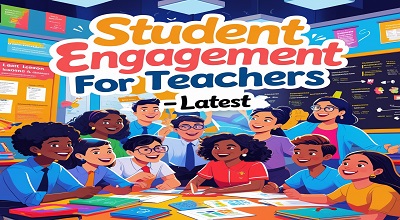Student Engagement Strategies
Engaging students in the classroom is a critical component of effective teaching. As educators, it is essential to implement strategies that not only capture students’ attention but also foster a deeper understanding of the material. This article explores the latest student engagement strategies that teachers can utilize to create a dynamic and interactive learning environment.
Understanding Student Engagement
What is Student Engagement?
Student engagement refers to the level of interest, motivation, and involvement that students exhibit in their learning process. Engaged students are more likely to participate actively in class discussions, collaborate with peers, and demonstrate a commitment to their educational journey.
Importance of Student Engagement
Engagement is crucial for several reasons:
- Improved Learning Outcomes: Engaged students tend to perform better academically.
- Increased Retention: Students who are actively involved in their learning are more likely to retain information.
- Enhanced Motivation: Engagement fosters a love for learning, encouraging students to pursue knowledge beyond the classroom.
Latest Strategies for Enhancing Student Engagement
1. Active Learning Techniques
Active learning involves engaging students in the process of learning through activities and discussions. Techniques such as group work, peer teaching, and hands-on projects can significantly enhance engagement. For instance, incorporating think-pair-share activities allows students to discuss their thoughts with a partner before sharing with the larger group, promoting collaboration and critical thinking.
2. Technology Integration
Utilizing technology in the classroom can captivate students’ attention and make learning more interactive. Tools like interactive whiteboards, educational apps, and online quizzes can create a more engaging learning experience. For example, platforms like Kahoot! allow teachers to create fun quizzes that students can participate in using their devices, making assessments more enjoyable.
3. Differentiated Instruction
Recognizing that students have diverse learning styles and needs is essential for engagement. Differentiated instruction involves tailoring lessons to meet the varying abilities and interests of students. This could mean providing different resources or activities based on students’ readiness levels, ensuring that all students are challenged and engaged.
4. Gamification
Incorporating game elements into lessons can motivate students and make learning more enjoyable. Gamification can include point systems, badges, and leaderboards to encourage friendly competition and participation. For instance, using educational games related to the curriculum can help reinforce concepts while keeping students engaged.
5. Collaborative Learning
Encouraging students to work together fosters a sense of community and belonging. Group projects, peer reviews, and collaborative problem-solving activities can enhance engagement by allowing students to learn from one another. This approach not only builds social skills but also deepens understanding through discussion and collaboration.
6. Real-World Connections
Connecting classroom learning to real-world scenarios can enhance relevance and engagement. Teachers can incorporate case studies, guest speakers, or field trips that relate to the curriculum, helping students see the practical applications of their studies.
7. Student Choice and Voice
Allowing students to have a say in their learning can significantly boost engagement. Providing options for assignments, projects, or topics of study empowers students and fosters a sense of ownership over their education. For example, teachers can let students choose between different project formats, such as a presentation, video, or written report.
8. Formative Assessment
Regularly assessing student understanding through formative assessments can help teachers gauge engagement levels and adjust instruction accordingly. Techniques such as exit tickets, quick polls, or one-on-one check-ins can provide valuable feedback and keep students accountable for their learning.
9. Building Relationships
Establishing strong relationships with students is fundamental to engagement. Teachers who take the time to understand their students’ interests, strengths, and challenges can create a more supportive and motivating classroom environment. Simple gestures like greeting students at the door or checking in on their well-being can make a significant difference.
10. Creating a Positive Classroom Environment
A positive and inclusive classroom atmosphere encourages student participation. Teachers can foster this environment by setting clear expectations, promoting respect, and celebrating diversity. Incorporating team-building activities can also help students feel more comfortable and engaged in their learning.
FAQs
1. What are some signs of student engagement in the classroom?
Signs of student engagement include active participation in discussions, asking questions, collaborating with peers, and showing enthusiasm for learning activities.
2. How can I measure student engagement?
Teachers can measure engagement through observations, student feedback, participation rates, and formative assessments that gauge understanding and interest.
3. What role does technology play in student engagement?
Technology can enhance engagement by providing interactive and dynamic learning experiences, allowing for personalized learning, and facilitating collaboration among students.
4. How can I differentiate instruction to engage all students?
Differentiation can be achieved by offering varied resources, adjusting the complexity of tasks, and providing choices in assignments to cater to different learning styles and abilities.
5. Why is building relationships with students important for engagement?
Building relationships fosters trust and respect, making students feel valued and understood. This connection encourages them to participate more actively in their learning.
Conclusion
Implementing effective student engagement strategies is essential for creating a vibrant and productive classroom environment. By utilizing active learning techniques, integrating technology, and fostering strong relationships, teachers can inspire students to take an active role in their education. As educators continue to adapt and innovate, the focus on engagement will remain a cornerstone of effective teaching practices.
